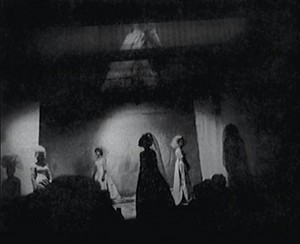Abstract: This talk will consider “Selma Last Year,” a largely forgotten multimedia installation that took place during the Winter of 1966 as part of the New York Film Festival’s fleeting interest in Expanded Cinema. A collaboration between the street theater producer Ken Dewey, Magnum photojournalist Bruce Davidson, and Minimalist composer Terry Riley, this groundbreaking media installation juxtaposed large scale projected images, an immersive audio collage, small scale photographic prints, 16mm documentary film, and a delayed video feedback loop to create a series of intentionally disjunctive environments.
Robert Elrod
The Media and Racially Motivated Crimes: From Selma to Ferguson
Andrew Uroskie’s presentation on Selma Last Year is a revealing look at the American media’s role in the Civil Rights Movement of the 1960s. The images of those who marched and the savagery of how they were treated while doing so put faces on the movement. They were front and center in the viewing public’s field of vision and allowed the public to acknowledge something outside of the typical white American experience, while simultaneously presenting identification for African-American viewers who shared experiences of oppression with those who marched. The media’s evolution in presenting racially motivated crimes since the events at Selma has been that of reporting not only the initial crimes and larger backdrops to them, but also events that at first seem unconnected yet actually grow out of these initial events. Within this media evolution there is a regrettable issue of decentering the victims of these crimes in the continual reporting on the events that follow by making the crimes the context for later events rather than being the main issue themselves. While this shift of focus does not necessarily represent an intentional movement away from African-American issues in the media, these shifts are an unfortunate side effect that audiences must be conscious of while reviewing the primary events (the crimes) and the secondary outcomes of those events (the larger contextual story) that unfold afterwards.
Gabriel Clermont Andrea Crowley-Hughes Alexandra Garza Wei Lee Devin Dowling
Site Specificity in the Digital Age
Immersive installations that combine music, visual art, and video are not out of the ordinary in today’s gallery scene, but in the mid to late 1960s, such installations were part of the forward-thinking movement known as “expanded cinema.” Andrew Uroskie, Associate Professor of Modern Art History and Criticism at SUNY Stonybrook, explored “Selma Last Year,” a 1966 collaboration between “happenings” artist Ken Dewey, civil rights photographer Bruce Davidson and minimalist composer Terry Riley, in an Understanding Media Studies lecture on November 10, 2014.
Rachael Bongiorno Stephanie Ronchi Frances Underhill Shoshana Greenspan
We have made a video response to Andrew Uroskie’s talk by creating a version of ‘Selma Last Year’ for the recent protests in Ferguson, Missouri. ‘Selma Last Year’ was a multimedia installation created by Ken Dewey, Bruce Davidson, and Terry Riley, which juxtaposed projected images, audio collage, small photographic prints and16mm documentary film, with a delayed video feedback loop. The intention was to create a series of intentionally disjunctive environments for the audience.
Asma Negash Stefan Melichar Robert Fazio Cristina Gonzalez-Delgado Alanna Caplin
A Discussion on Andrew Uroskie’s Presentation on Selma Last Year
Robert: Initial reactions to Andrew Uroskie’s presentation on Selma Last Year were varied. Heading into this presentation, I had many questions: why is there going to be a presentation on something that was neglected by the art community and ultimately forgotten? How am I supposed to understand this complex and emotionally exhausting exhibit by listening to someone describe it?
